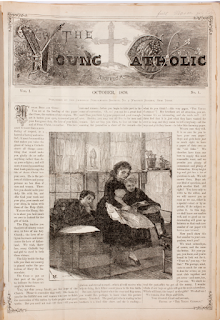Reading Children
 |
| My Darling's A.B.C. (1830s-40s) in the collections of the American Antiquarian Society. Photograph by author. |
 |
| Photograph by American Antiquarian Society via Twitter. |
In our readings and discussions, we interrogated ideologies of literacy, literature, and print culture inflected by race, class, and gender to answer this question. But as our conversations developed, I became increasingly interested in the ways we were and were not talking about religious reading, or religious children--surprising, I thought, given the extent to which the market for pre-twentieth century children's books was inflected by religious publishers and religious and moral instruction. [The very notions of children and childhood can't really be discussed without considering religious ideas--just look at Webster's 1828 dictionary definitions of child to get started!]
 |
| The Young Catholic volume 1 issue 1, courtesy American Antiquarian Society. |
As I reorganized my notes, I returned to a short blog post I wrote on my own website nearly two years ago to keep track of a Lincoln Mullen's call on Twitter for sources in the study of American children and religion. (A helpful bibliography resulted from that conversation.) Of course, when I clicked on the subject category "children" right here on RiAH, I found a number of posts from the last few years, that might bear reviewing if you, like me, are increasingly interested in what childhood studies means for your work:
- Samira Mehta's recent interview with Jodi Eichler-Levine, author of Suffer the Little Children: Uses of the Past in Jewish and African American Children's Literature;
- Laura Leibman's post on Religion and Toys;
- Michael J. Altman's call, Someone Should Write a Book About Vacation Bible School;
- Brantley Gasaway's Research on Christian Homeschooling; and
- Chris Cantwell's "Suffer the Little Children," on child preachers.
Apparently I've been interested in childhood all along! As I continue to explore the histories of American Catholic childhoods, then, I'd appreciate other reading suggestions in the comments. How do religious children, or reading children, figure into your work?
* * *
For more on the AAS History of the Book in American Program, visit the AAS website. A good place to start exploring the AAS collections is their rich online catalog; additionally, Laura Wasowicz has published the Nineteenth Century American Children's Book Trade Directory as a guide.
I've used Storify to collect just a few of my notes from "Reading Children," here.
The Program in the History of the Book in American Culture summer seminar topic is announced in the winter, with applications due in mid-March. A second summer seminar, organized by CHAViC, the Center for Historic American Visual Culture at AAS, also offers a one-week course each summer, providing additional guided opportunities for scholars and educators to learn about resources in the Society's collections, stimulating research and intellectual inquiry into these materials. I am grateful to the AAS for the tuition scholarship that made it possible for me to attend this year's program.

Comments